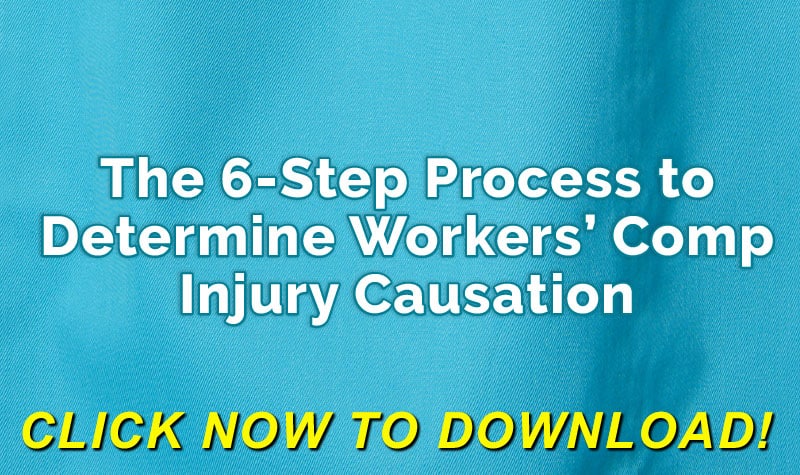
NSAIDs — nonsteroidal anti-inflammatory drugs— have become one of the medications of choice to treat pain. These can be very effective and don’t carry the risks of addiction or dependence of opioids. However, the problem is the potential negative effects on the cardiovascular system. Care needs to be taken when prescribing them, especially to older workers.
Click Link to Access Free PDF Download
“The 6-Step Process To Determine Workers’ Comp Injury Causation”
The situation is something of a Catch-22; older injured workers often have pain, but they are typically more vulnerable to problems of the cardiovascular system. Payers can help protect injured workers who are prescribed these medications by understanding the risks, educating patients and exercising caution.
NSAIDs and Cardiovascular Issues
NSAIDs are often used to treat mild to moderate pain. They are especially helpful for pain caused by inflammation, such as arthritis or a sports-type injury.
NSAIDs are drugs with analgesic, anti-inflammatory, and antipyretic activity. Some of the commonly used over-the-counter varieties are ibuprofen, such as Motrin and Advil; and naproxen sodium, or Aleve and Anaprox. Prescription NSAIDs include Celecoxib, or Celebrex; and diclofenac, known as Cataflam and Voltaren. Aspirin, which is an NSAID, does not pose a risk of heart attack or stroke and is commonly used to prevent those conditions.
Gastrointestinal problems associated with NSAIDs are well known. But researchers have also found that these medications can increase blood pressure and lead to congestive heart failure, as well as acute myocardial infarction.
The Food and Drug Administration warned of the potential risks of heart attack or stroke from NSAIDs in 2005. Ten years later the agency strengthened its warning, based on the advice of an expert panel that had reviewed additional information.
The risk was especially noted when the drug rofecoxib, or Vioxx, was on the market. It was removed in 2004, after being associated with as many as 140,000 heart attacks in the U.S. during the five years it was sold. It prompted further research about the risks of heart attack and stroke from NSAIDs in general.
According to the FDA:
- The risks of heart attacks and strokes increase even with short-term use of NSAIDs and may begin within a few weeks of taking the medications.
- The higher the dose of NSAID, the higher the risk. Also increasing the risk is the length of time the medications are taken.
- People most at risk are those who already have heart disease, although others can also be at risk.
Patients taking diuretics may be at the highest risk of heart attack or stroke, especially during the first few weeks of taking NSAIDs.
Preventing NSAID Risks
Taking NSAIDs for a few days to relieve pain generally carries just a small risk, for most people. Employers and payers can help ensure injured workers are less at risk of developing heart attacks or strokes from the medications through the following strategies:
- Monitor for signs and symptoms of adverse effects.
- Educate injured workers and family members on the risks, especially those more at risk.
- Prescribe the lowest dosage possible.
- Prescribing taking the drugs for only a limited period of time.
- Try alternative remedies for people who have heart disease, if at all possible.
- Do not take more than one type of NSAID at a time.
- Try alternative medications, such as acetaminophen. Be aware, however, that this drug can cause liver damage if the daily limit exceeds 4,000 milligrams or if the person drinks more than three alcoholic beverages a day.
- Suggest week-long NSAID ‘holidays’ on occasion.
- Advise the injured worker to get medical attention immediately if he experiences chest pain, shortness of breath or sudden weakness or difficulty speaking.
- For muscle or joint pain, suggest hot or cold packs or physical therapy before NSAIDS, for those more at risk.
- Injured workers already taking aspirin to prevent a heart attack should talk with their physician first, as some NSAIDs may hamper the aspirin’s effectiveness.
Conclusion
The workers’ compensation industry has made inroads in curbing the unnecessary use of opioids. However, care needs to be exercised before giving an injured worker a blanket recommendation or prescription for NSAIDS, especially for people who have pre-existing heart-related conditions. As with all medications, moderation is key.

Contact: mstack@reduceyourworkerscomp.com.
Workers’ Comp Roundup Blog: https://blog.reduceyourworkerscomp.com/
©2019 Amaxx LLC. All rights reserved under International Copyright Law.
Do not use this information without independent verification. All state laws vary. You should consult with your insurance broker, attorney, or qualified professional.







